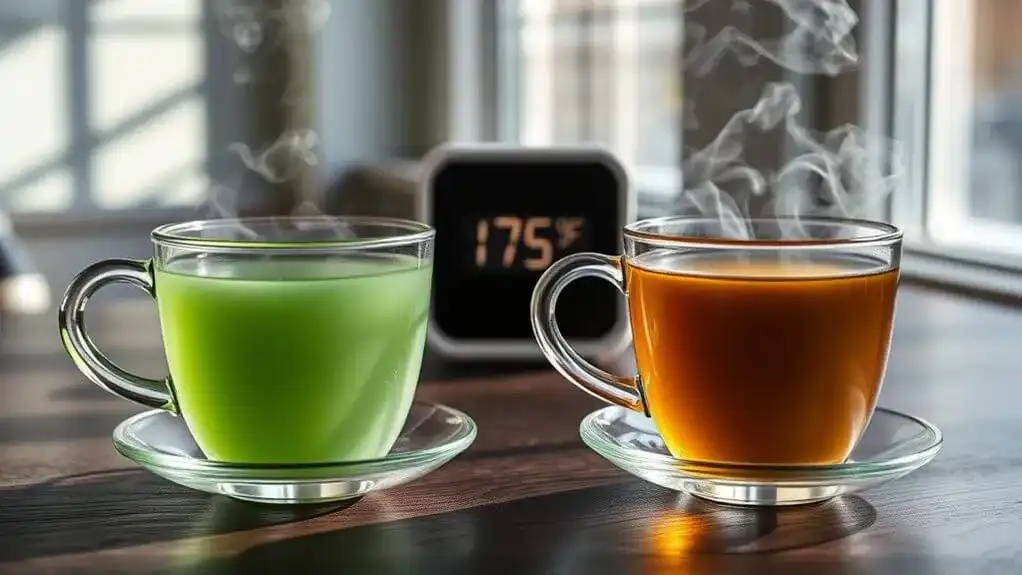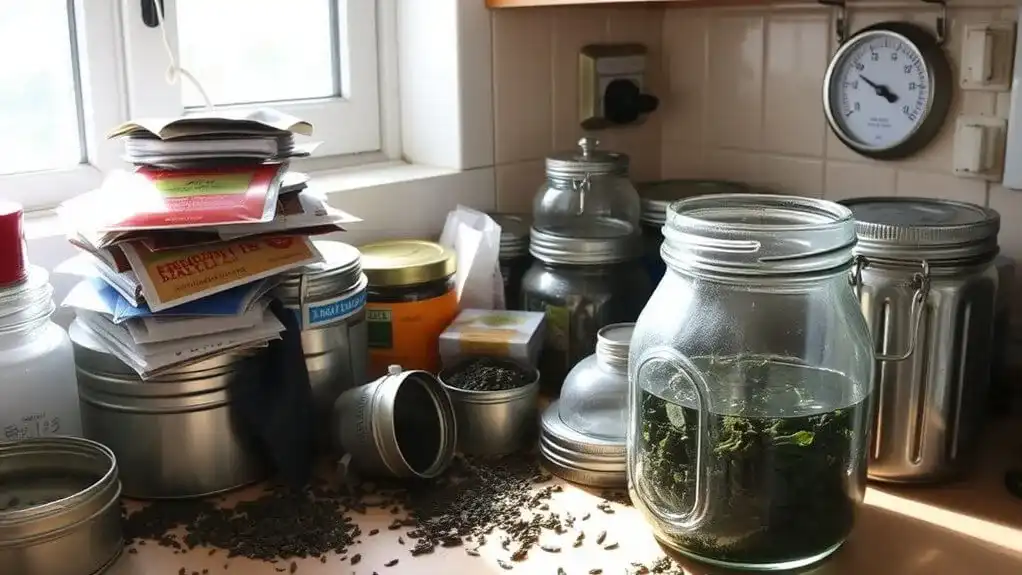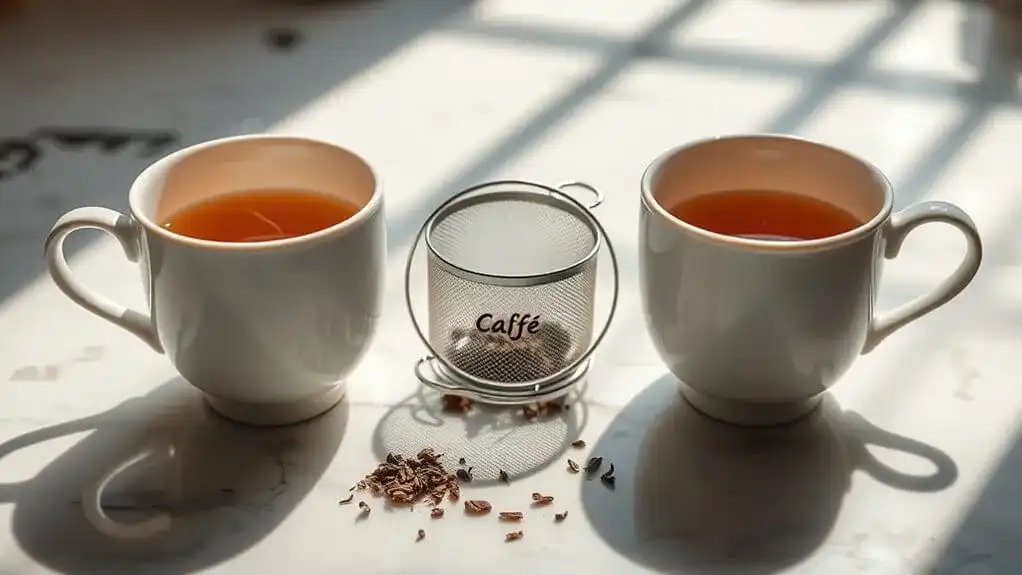Water temperature plays a crucial role in brewing the perfect cup of tea. Different tea varieties require specific temperatures for ideal flavor – black teas need near-boiling water (200-212°F), while delicate green teas thrive at lower temperatures (140-190°F). Using the wrong temperature can result in bitter, weak, or off-tasting tea. With the right tools and knowledge of proper brewing temperatures, tea lovers can access their favorite tea's full potential and subtle complexities.
Key Points
- Different tea types require specific water temperatures: green tea (140-190°F), black tea (190-212°F), and delicate teas (140°F).
- Using water that's too hot for green teas causes bitterness, while too-cool water makes black tea taste weak.
- Temperature control kettles and thermometers help achieve precise brewing temperatures for optimal flavor extraction.
- Proper water temperature prevents over-extraction of tannins and caffeine, ensuring a balanced and enjoyable tea experience.
- High-quality water and warmed teaware enhance the tea's natural flavors and aromas during brewing.
Why Temperature Makes or Breaks Your Tea
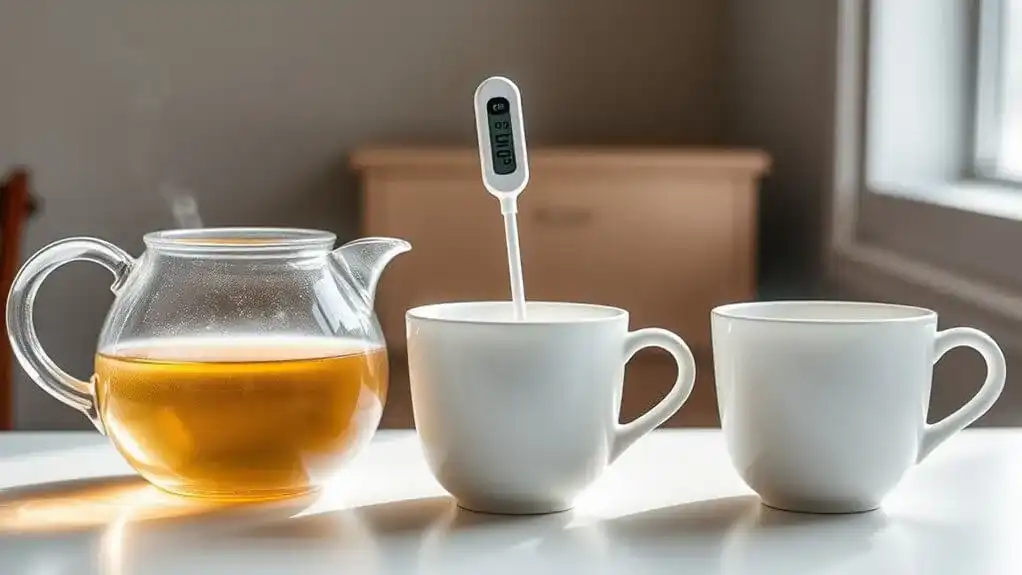
When it comes to brewing the perfect cup of tea, water temperature isn't just a minor detail – it's an important factor that determines the final taste. Different types of tea leaves show remarkable temperature sensitivity, with each variety requiring specific heat levels to release their ideal flavors. Precise temperature control can be achieved using specialized kettles with built-in thermometers. Japanese green teas are particularly delicate and require cooler brewing at 60-70°C. Yellow teas perform best when brewed at higher temperatures of about 90°C.
For delicate teas like green and white varieties, lower temperatures between 160-185°F prevent bitterness and preserve subtle aromatics. Black teas, however, need hotter water around 200-212°F to fully develop their robust character. Among the significant brewing variables, temperature control helps prevent over-extraction of compounds like tannins and caffeine, which can lead to unwanted bitterness. The right temperature also guarantees proper leaf unfurling and consistent extraction of flavors, making it essential for achieving that perfect balance of taste and aroma in every cup.
The Science Behind Perfect Tea Brewing
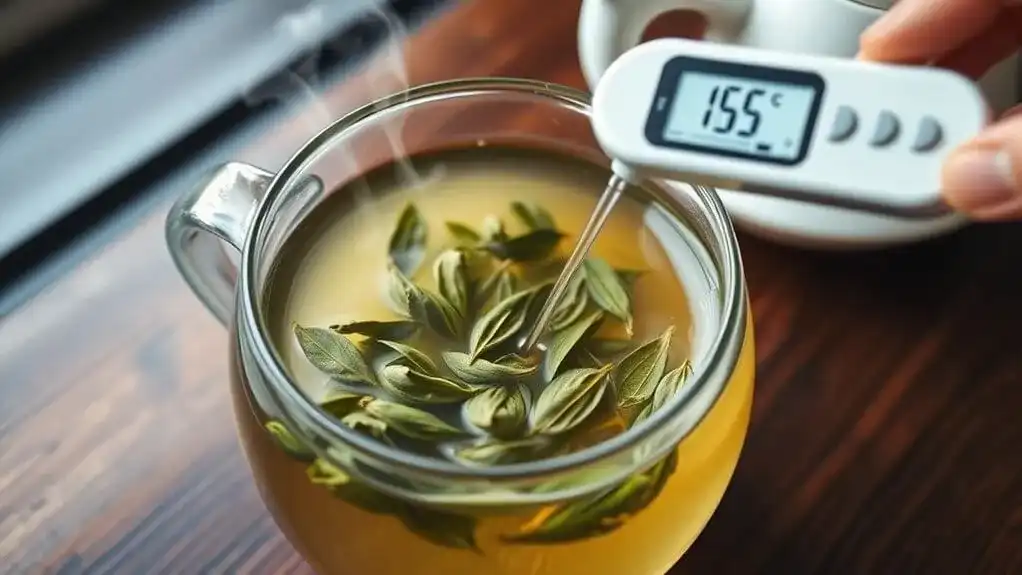
The intricate chemistry behind tea brewing reveals why precision matters in every cup. When hot water meets tea leaves, a series of chemical reactions begins, releasing polyphenols and tannins that create distinct flavor profiles. The temperature of the water directly controls how these compounds are extracted, with higher temperatures causing faster diffusion of tea's components. Traditional kettles provide more consistent heating compared to microwaves, ensuring optimal extraction throughout the brewing process. Using cooling bowls can help achieve precise temperatures for delicate teas. Quick heating of leaves before oxidation occurs is essential for producing authentic green tea, as this step halts enzyme activity.
Water quality plays a significant role in this process. Hard water can trigger stronger reactions between calcium and polyphenols, leading to tea scum formation, while soft water allows for cleaner extraction. The oxidation level of different tea types also demands specific temperatures – black teas thrive in near-boiling water, while green and white teas require gentler heat to prevent bitter overtones. Understanding these interactions helps achieve the perfect balance of flavors in every brew.
Finding Your Tea's Sweet Spot
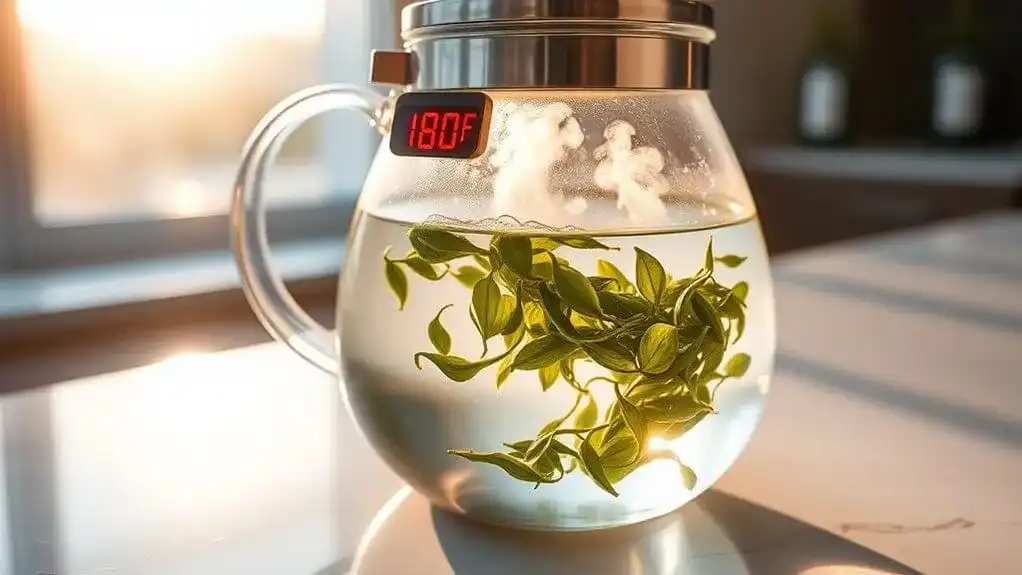
Armed with an understanding of tea's chemical properties, finding the right temperature for each variety becomes a logical next step. Different tea varieties require specific temperatures to achieve ideal flavor. Green teas thrive at lower temperatures between 140-190°F, while black teas need hotter water at 190-212°F to fully release their compounds.
Mastering brewing techniques means recognizing that temperature isn't just a suggestion – it's essential for preventing bitter over-extraction or weak under-extraction. For delicate teas like Gyokuro, water at 140°F preserves its subtle flavors, while robust Pu-erh can handle boiling temperatures. Japanese green teas especially require gentle heating temperatures to preserve their delicate flavors and prevent bitterness. Using a tea infuser basket allows leaves to fully expand and release optimal flavor during steeping. Without specialized equipment, tea enthusiasts can still achieve proper temperatures by letting boiling water cool or watching for visual cues during heating. Understanding that amino acids dissolve at different rates during the brewing process helps explain why temperature control is so crucial. The key is consistency and attention to each tea's specific needs.
Common Temperature Mistakes to Avoid
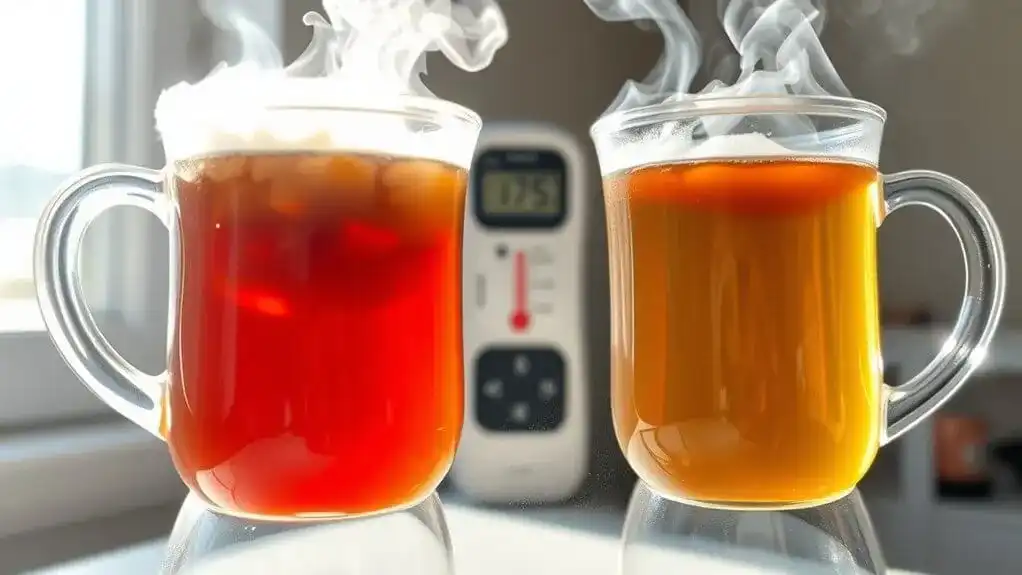
Many tea enthusiasts stumble into common temperature pitfalls that can drastically affect their brewing results. One frequent mistake is using water that's too cool for black teas, resulting in weak, under-extracted flavors instead of the rich, full-bodied taste they're known for. Another error occurs when brewing delicate green and white teas with boiling water, which can burn the leaves and create bitter, astringent notes. Quality tea supplies can help ensure proper temperature control and consistency. Proper temperature is crucial as beneficial tannins can be destroyed when using water that's too hot.
Understanding brewing temperature nuances is essential for each tea variety. While black teas thrive at 212°F, green teas need a gentler touch at 175-180°F, and Japanese varieties like sencha require even cooler temperatures of 160-175°F. Using a thermometer and proper cooling methods, such as timing the cooling process or adding ice cubes, helps achieve the precise temperatures needed for ideal flavor extraction. A pinch of salt can help balance out any accidental bitterness from temperature mistakes.
Essential Tools for Temperature Control
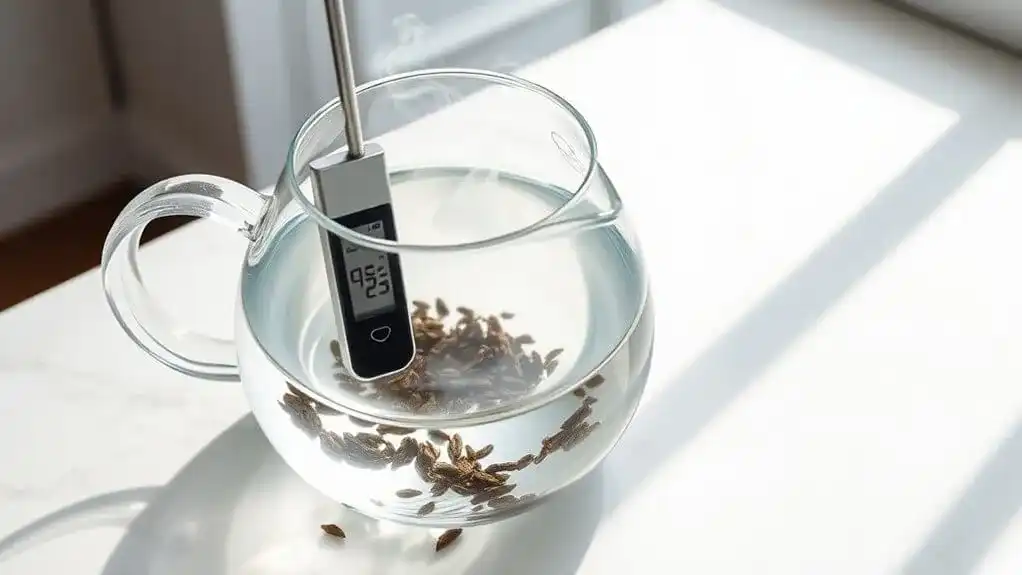
Four essential tools revolutionize temperature control in tea brewing, ensuring consistent and ideal results every time. Temperature control kettles lead the pack with their precise settings and digital displays, making it easy to achieve the perfect brewing temperature accuracy for different tea varieties. The ability to adjust to precise temperatures helps achieve optimal brewing for specific tea types. Different teas require vastly different temperatures from white tea at 158°F to black tea at boiling.
For those using traditional kettles, thermometers serve as reliable temperature control gadgets, helping measure water temperature with precision. Modern dispensers like the 10-liter capacity tea warmer provide reliable temperature maintenance for up to 8 hours, perfect for serving multiple guests. Insulated dispensers play a significant role by maintaining the ideal temperature over extended periods, featuring high-quality materials and monitoring capabilities.
Smart brewing devices round out the essential toolkit, offering programmable settings and advanced features for various tea types. These modern tools often include digital interfaces and scheduling options, taking the guesswork out of brewing and delivering optimal flavor extraction every time.
Master Guide to Tea Types and Temperatures
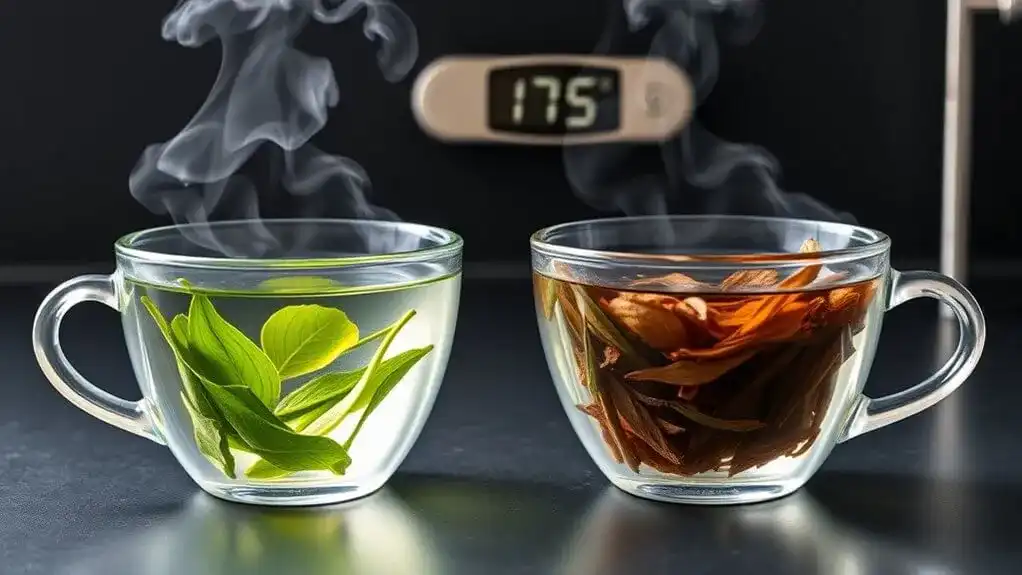
Once you've gathered the right temperature control tools, understanding the specific heat requirements for each tea variety becomes the next step toward brewing excellence. Different tea varieties demand distinct brewing guidelines to achieve their ideal flavor profiles. Testing the quality of your tea by rinsing the leaves helps ensure optimal flavor development before the main brew.
Black tea and herbal infusions thrive in boiling water at 212°F, while green tea needs a gentler touch at 160-175°F. White tea prefers even cooler temperatures between 150-170°F. Oolong sits comfortably in the middle range at 190-200°F. Specialty teas like pu-erh can handle boiling water, but mate tea requires a much lower temperature of 150-160°F. Jasmine tea's temperature needs vary based on its base tea type. For green tea enthusiasts, keeping temperatures under 175 degrees prevents unwanted bitterness from developing. Following these temperature guidelines helps access each tea's unique characteristics and guarantees a superior cup every time.
Tips for Precise Temperature Management
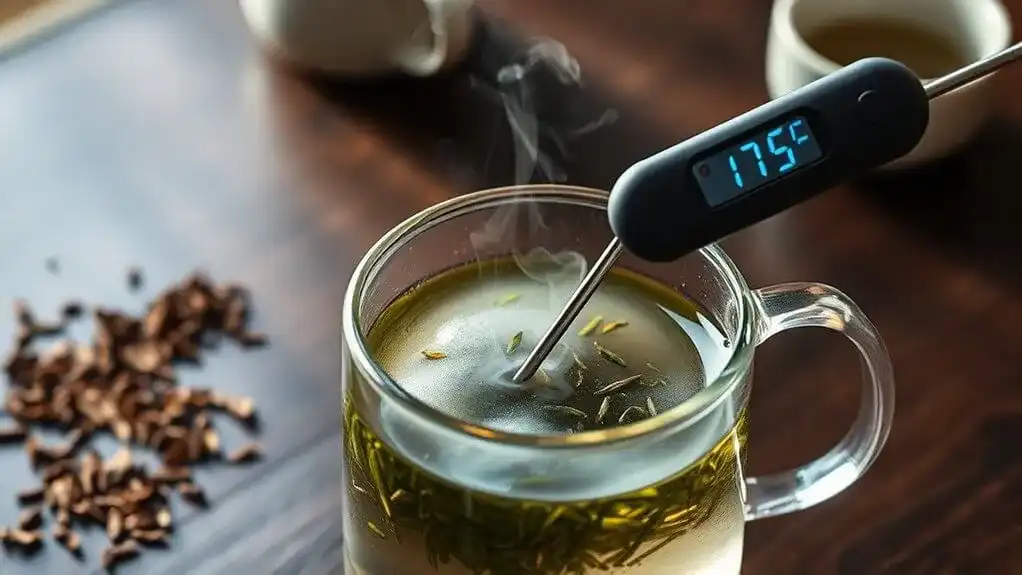
Achieving precise temperature control stands as the cornerstone of exceptional tea brewing. The right temperature calibration guarantees peak extraction while preventing bitter or weak flavors. Tea enthusiasts can master this art through several reliable cooling techniques.
Electric kettles with built-in temperature controls offer the most precise method, but traditional approaches work just as well. Let boiled water sit for a few minutes, use ice cubes for quick cooling, or employ a cha hai to reach desired temperatures. A kitchen thermometer helps verify accuracy, especially when aiming for specific temps like 175°F for green teas or 212°F for black teas. BRU Maker One streamlines this process with its preset programs for different tea varieties.
Remember that each tea type demands its own temperature range, and it's worth experimenting to find the perfect balance. Even slight adjustments can dramatically impact the final cup's taste.
Transforming Your Tea Experience
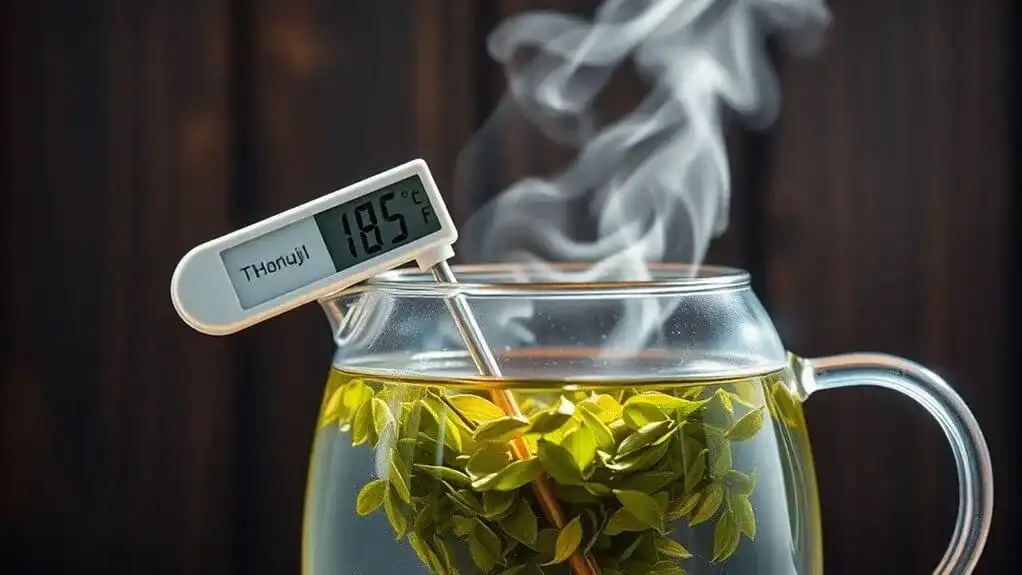
Through mindful attention to temperature and technique, tea enthusiasts can transform their daily brewing ritual into an enriching sensory journey. By warming teaware before use and selecting high-quality water, they'll reveal deeper flavors and enhance the tea's natural aroma. Using clear cups helps concentrate the fragrance, making aroma enhancement a key part of the experience. Evaluating the tea's liquor requires a white porcelain cup for accurate color assessment.
The process of pure tasting practice helps develop and refine your ability to detect subtle flavors without interference from additives. Flavor exploration becomes more rewarding when enthusiasts document their tastings in a tea journal and experiment with different water sources. They'll discover how varying temperatures release distinct compounds in different tea types – from delicate green teas at lower temperatures to robust black teas at near-boiling points. By avoiding external scents and focusing on the tea's intrinsic qualities, drinkers can develop a more refined palate and appreciate the subtle nuances that proper brewing temperatures reveal.
Taking Your Tea Skills to the Next Level
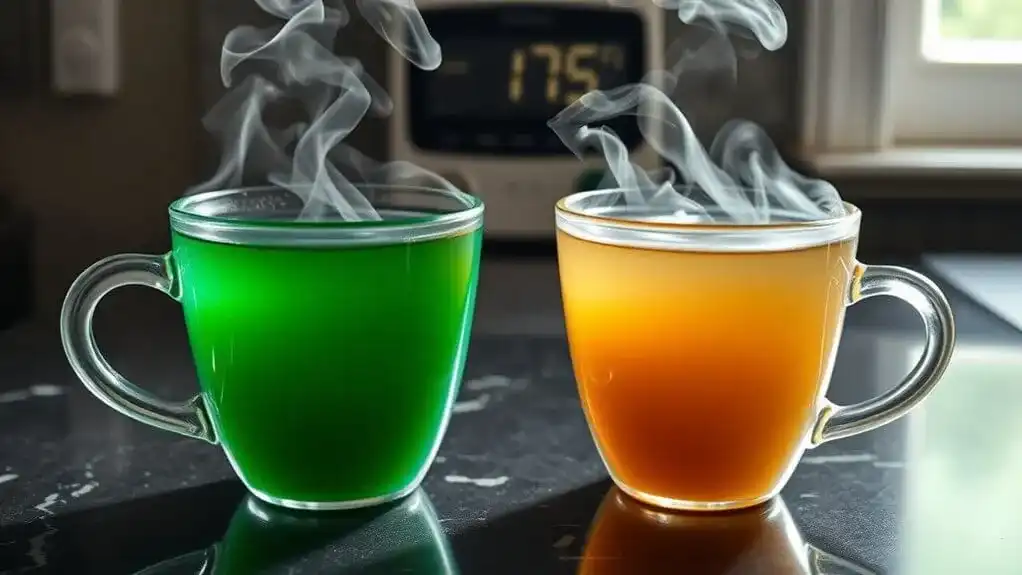
As tea enthusiasts progress beyond basic brewing, they'll discover that mastering advanced techniques requires attention to precise temperature control and specialized brewing methods. To elevate their tea rituals, they should experiment with both Western and Gongfu brewing styles, each offering unique ways to reveal different flavor profiles. Hot water enhances tea's aromatics and complexity, making temperature control essential for optimal extraction. For green teas specifically, using cooler temperatures between 175-185°F produces the best results without bitterness. The Gongfu method allows tea lovers to steep repeatedly and experience how flavors evolve across multiple infusions.
Serious tea crafters can benefit from keeping detailed records of their brewing parameters, including water temperature, steep times, and leaf-to-water ratios. Using high-quality equipment, like precise thermometers and standardized teaware, helps guarantee consistency in every cup. The most successful tea brewers also understand that each tea variety demands its own specific approach, from delicate green teas requiring lower temperatures to robust black teas that can withstand higher heat. With practice and patience, these advanced techniques become second nature.
Conclusion
Like a master conductor leading an orchestra, the perfect cup of tea requires precise temperature control to reveal its full symphony of flavors. When you've mastered this delicate dance between heat and leaf, you'll transform simple water and tea into liquid poetry. The kettle's steam rises like morning mist, carrying the promise of perfectly brewed tea that's no longer just a drink—it's become an art form.
